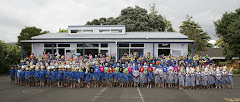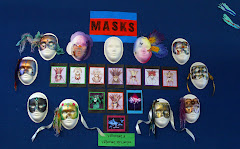To address the problem of students running out of steam during the sculpture part of mask making Multimask has been developed to enable students to tell a visually interesting story with big impact, but with less mess and energy waste. Multimask frees up classroom time for in-depth studies in the curriculum of the diverse cultural & sociopolitical contexts that produce mask making. Patty Bode's stellar article featured in Rethinking Schools Online about making Puerto Rican Vejigante Masks in class redefines multicultural visual arts education: http://www.rethinkingschools.org/archive/17_01/Puer171.shtml
The Vejigante (bay-he-GAHN-tay) is a fantastic, colourful character introduced into the carnival arts hundreds of years ago, and is a classic example of the blending of African, Spanish, and Caribbean influences in Puerto Rican culture.
Maskblogs
Explore our other Multimask Pages
Questions & Feedback MULTIMASK ASKBLOG
http://maskask.blogspot.com/
Community Support MULTIMASK MASKITECTURE
http://maskitect.blogspot.com/
Maskworx Photo Gallery MULTIMASK SHOWOFFS http://www.photoblog.com/showoffs
Questions & Feedback MULTIMASK ASKBLOG
http://maskask.blogspot.com/
Community Support MULTIMASK MASKITECTURE
http://maskitect.blogspot.com/
Maskworx Photo Gallery MULTIMASK SHOWOFFS http://www.photoblog.com/showoffs
IMAGINE. CREATE. SHARE or WEAR...
Welcome to MASKS2GLOBE - your maskblog dedicated to imagining, creating, and sharing children's mask works from classrooms everywhere....
Please remember to send in your best digital mask pictures to annette@maskworx.co.nz so we can post them on SHOWOFFS; a comprehensive showcase of educational mask work!
Please remember to send in your best digital mask pictures to annette@maskworx.co.nz so we can post them on SHOWOFFS; a comprehensive showcase of educational mask work!
Monday, December 10, 2007
Saturday, November 24, 2007
Eat your Nose!!
 Did you know…centuries ago in Europe (circa 1500’s) when doctors visited their patients they wore masks with enormous beaky noses!
Did you know…centuries ago in Europe (circa 1500’s) when doctors visited their patients they wore masks with enormous beaky noses!The Plague Doctor mask was used by doctors during periods of plague. During that era doctors had a very limited understanding of microbes (germs) that caused diseases and understood that the plague was caused by malevolent “spirits”. They wanted to keep the spirits away by frightening them, which explains the terrifying appearance of the beaked mask and dark waxed canvas costume they wore.
To avoid contact with the afflicted, the mask’s eyeholes were covered with glass and any examinations conducted by the doctor were done with a hand held stick. So the doctor could breathe behind his mask, air - filtered by aromatic herbs hidden inside the nose - passed through two slits cut in the “beak”.
One snowy morning in Dunedin, a local teacher was demonstrating the Plague Doctor mask to her junior class. Earlier she had secretly stuffed the mask's nose with the traditional herbs and scented lavender flowers as well as a generous handful of gourmet jellybeans!
The teacher said, pulling jelly bean 'bogies' from a plague doctor’s NOSE was "one of the stranger things" she'd done in her teaching career… but the kids loved it!
Wednesday, November 21, 2007
Handy Hint - make a demo set

When instructing large numbers of students (school holiday groups) or very young children (5-8 years) it is useful to make your own Demo Set of the nine basic shapes. Simply order an extra ten Multimasks, cut out one of each shape as outlined by the embossed guidelines on the back. This way students can easily see a representation of each shape, choose their favourite at a glance, then bung it on top of their own Multimask, draw around it and hey presto...'instant mask' they can cut out and embellish. Speeds things up and everyone has a good time from the Get Go! Keep your educator's demo set in a ziplock bag to use over and over again.
Thursday, November 15, 2007
"Ippinquill" - a Carnival Arts character
 To celebrate the November '07 launch of our new website MASKWORX has devised "Ippinquill" a new 'carnival arts' character. Using only scissors and a pencil (plus 2 buttons) Ippinquill emerges from a stack of about 15 Multimask classic face shapes as a carnivalesque (happily exaggerated) face scape - the beginning of a visually interesting story. Who is Ippinquill? What would Ippinquill's habitat look like? What is Ippinquill's favourite food? Why is Ippinquill here?
To celebrate the November '07 launch of our new website MASKWORX has devised "Ippinquill" a new 'carnival arts' character. Using only scissors and a pencil (plus 2 buttons) Ippinquill emerges from a stack of about 15 Multimask classic face shapes as a carnivalesque (happily exaggerated) face scape - the beginning of a visually interesting story. Who is Ippinquill? What would Ippinquill's habitat look like? What is Ippinquill's favourite food? Why is Ippinquill here?You can answer these questions by colouring in the visual details yourself, adding textures, tones and tiny props for a truly three-dimensional story of who this carnival arts character is?
Begin by cleverly cutting out your own "Ippinquill":
Cut & free the jaw like a ventriloquists doll, secure with elastic bands
Cut a 'handlebar moustache' from the forehead of 2x Multimasks
Cut nose-brow shapes from 2x Multimasks
Cut 11 extra 'noses' and assemble 8 of them in layers (saving 3 for 'tongue' and 'ears')
Arrange 1 mini-nose upsidedown as a 'tongue' and 2 mini-noses as 'ears'
Cut cheekbones from the moulded chin of 2x Multimasks and another to form the spiral (at top)
Affix all cutouts with adhesive dots, add buttons or beads for 'eyes' then colour your composition in...
Friday, October 26, 2007
Unmask their Talent
 Educator Tip - the Brief
Educator Tip - the BriefEducators can help students learn how to generate original ideas, designs, and composition by giving them a clear brief before they start their mask project...
It is not enough to tell students “Just be creative” as few have the initiative, thinking skills and confidence to turn ideas into products from the get-go. Often students may be tempted to borrow ideas from others. Jonathan Milne, Creative Director of the learning connexion suggests copying and uniqueness can go hand in hand. He says: "Just as your copied genes [from your parents] come out as something unique, so does art". His free advice for learners is: "When copying, be yourself" [make it your own].
Another important tip “just being creative” is not a mandate to make 'dark' stuff that scares people. As artist Juliet Novena Sorrel says: "The NEW risk is to make something beautiful". The best imaginative thinking begins within clear guidelines. Especially in a situation like mask making - where anything is possible - remember to brief the learner so they can unmask their creativity safely. Young people love boundaries.
Thursday, October 11, 2007
The Mask Made Me Do It!

Did you know…the history of masks and vice in Venice is incredible. Centuries ago the Venetians devised an extreme example of liberty using a special mask called La Gnaga.
Made of light papier mache, the Gnaga mask covered half of the face, leaving the mouth free. La Gnaga wearers openly provoked townsfolk on the street with a multitude of obscenities spoken in a gruff voice. This harsh voice made them sound like cats, which in Venetian is ‘gnau’ which explains the name of this mask.
With their mask La Gnaga on, the wearer could not be arrested however strange or disorderly his/her behavior (unless really violent or dangerous), because he/she became a “masked person”, and officially any mask was acting out a role, or playacting. If apprehended for infringing the law, the exuberant mischief-maker could simply retort: “The Mask made me do it” and get away with it!
A nice trick, but don’t expect it to work in today’s world. Nowadays, it’s not the mask itself that liberates. It's the act of making masks that switches on valuable new ways of seeing and thinking to liberate the creative process. There is something liberating about making your own stuff.
Made of light papier mache, the Gnaga mask covered half of the face, leaving the mouth free. La Gnaga wearers openly provoked townsfolk on the street with a multitude of obscenities spoken in a gruff voice. This harsh voice made them sound like cats, which in Venetian is ‘gnau’ which explains the name of this mask.
With their mask La Gnaga on, the wearer could not be arrested however strange or disorderly his/her behavior (unless really violent or dangerous), because he/she became a “masked person”, and officially any mask was acting out a role, or playacting. If apprehended for infringing the law, the exuberant mischief-maker could simply retort: “The Mask made me do it” and get away with it!
A nice trick, but don’t expect it to work in today’s world. Nowadays, it’s not the mask itself that liberates. It's the act of making masks that switches on valuable new ways of seeing and thinking to liberate the creative process. There is something liberating about making your own stuff.
Subscribe to:
Posts (Atom)




